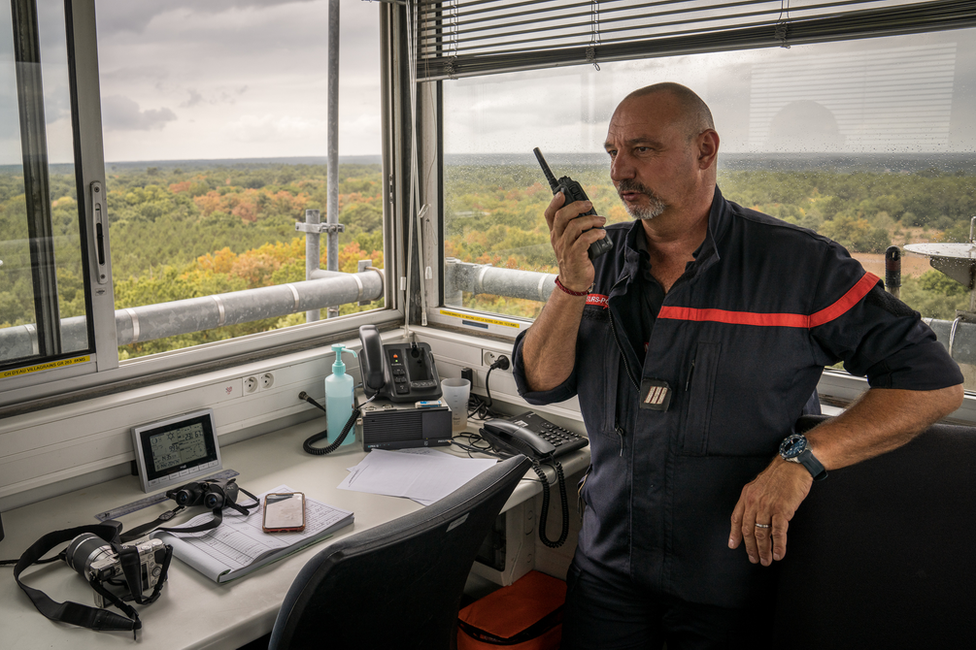Forty metres above the forest, searching for smoke
- Published

Manuel Escutia was the first firefighter to set eyes on the blaze that consumed 14,000 hectares of southern France in July.
When he saw it, from his perch 40m (131ft) above the forest, it was a small cloud of black smoke rising from the trees about 5km away. Escutia had just done a circuit of his watchtower and he was about to go back inside the small cabin at its centre when the smoke caught his eye. It was too dark to be a small cigarette or barbecue fire. It was being fuelled by petrol, Escutia thought. According to his log book, it was 4.30pm on 12 July.
"I immediately assumed it was of criminal origin, because of the colour of the smoke," Escutia recalled on Sunday, atop his tower.
Escutia crouched down in front of his alidade - an age-old, compass-based device - and sighted the fire: 152 degrees, southwest. He went inside the cabin and called it in to command. "Sending the smoke," Escutia called it. The call set off relays to three other fire watchtowers in the immediate area, to triangulate the precise location.
Escutia went back outside and watched. Ten minutes after his first sighting, he could see flames jumping from treetop to treetop, 20m above the ground, and the firefront was 150m long.
"I knew straight away it was going to be bad, because the temperature was high and the wind was also high," Escutia said. "But I could not have imagined it would spread as far as it did."
The network of 22 watchtowers dotting this forest in Gironde in southern France is the first line of defence against wildfires, which can begin with just a wisp of smoke on the horizon. Escutia, a former moving company owner, has a contract with the fire service to work up in the tower for six months, over the summer fire season, but he also works outside of his contract as a volunteer. He is in his fourth year on the fire service. When the July blaze was really bad, a handful of times Escutia finished his shift on the tower at 10pm and joined the firefighters on the frontline at midnight for a shift until 7am, then returned to the watchtower at 10am. "I didn't sleep very much," he said, with a smile.
From Escutia's watchtower, on Sunday, it was possible to trace how far the fire had travelled. A long arc of burned trees stretched a full quarter of his 360-degree view. "I had never seen such a big fire, so violent, the kind of fire that produces its own wind," Escutia said. He felt a deep sadness when he saw how quickly it was burning, he said. "I knew the plant life and the animals were going to suffer."
The blaze was eventually brought under control, but the forest peat had become so hot and the vegetation so dry that it started again from the same spot, last Tuesday, and burned another 7,400 acres.
The second fire was spotted from the same tower, but by Escutia's colleague. Escutia was up in a helicopter at the time taking pictures for the fire department. He takes his job immensely seriously. "When I'm up in the tower I patrol at least every 15 minutes," he said. "I do not sit on the chair in the cabin and watch a movie. It would not be serious."
The men and women of the Gironde fire department (85% men, 15% women) are required to live within 10 minutes of the station, in case they are needed in a hurry. Unlike some regional fire departments, which rely increasingly on cameras and remote control rooms, Gironde has stuck to the old fashioned method of having people up tall towers to watch out for smoke.
"They know their tower, they know the view, they can say that the smoke is so far away or near such and such location," explained Captain Francois Perekrestow, from the Gironde fire department.
The people who man the towers must undergo physical tests, as well as three days of training on how to gauge distance and read smoke, which can tell you by its colour about the fuel source and by its shape about the strength of the wind.
The department pays people to be up there during the fire season, traditionally April to September. But in recent years, the fire season, dictated by temperatures and dryness, has been beginning earlier and ending later. This year it began officially on 1 March and will stretch into October. "The fear for the future is that it will begin in February," Captain Perekrestow said.
On Saturday night, long awaited rains fell on Gironde and partially soaked the forest. It wasn't enough to put out the fire, but from Escutia's perch on Sunday the vast woodland looked lush and verdant. It was not hard to imagine the sadness of watching it burn for the man who has carefully watched over it for years.
Being the first one to spot the big July fire did not make him any kind of hero, Escutia said. He was just one man doing his job. "I'm glad I raised the alert quickly but I would prefer not to have to," he said.
After the rainfall, all was quiet 40m above the forest. But the risk level remained high, Escutia said. He was as vigilant as ever. "Watching is my job," he said. "It is a bigger responsibility than it might seem."
Photographs by Joel Gunter
Read more
Related Topics
- Published14 August 2022
- Published14 November 2019
- Published11 August 2022
- Published20 July 2022